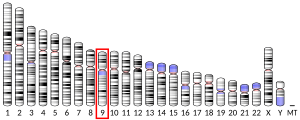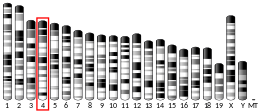FANCG
FANCG| FANCG | |||||||||||||||||||||||||
|---|---|---|---|---|---|---|---|---|---|---|---|---|---|---|---|---|---|---|---|---|---|---|---|---|---|
| 식별자 | |||||||||||||||||||||||||
| 별칭 | FANCG, FAAG, XRCC9, 팬코니 빈혈보완그룹 G, FA보완그룹 G | ||||||||||||||||||||||||
| 외부 ID | OMIM: 602956 MGI: 1926471 호몰로진: 3402 GeneCard: FANCG | ||||||||||||||||||||||||
| |||||||||||||||||||||||||
| |||||||||||||||||||||||||
| |||||||||||||||||||||||||
| |||||||||||||||||||||||||
| 직교체 | |||||||||||||||||||||||||
| 종 | 인간 | 마우스 | |||||||||||||||||||||||
| 엔트레스 | |||||||||||||||||||||||||
| 앙상블 | |||||||||||||||||||||||||
| 유니프로트 | |||||||||||||||||||||||||
| RefSeq(mRNA) | |||||||||||||||||||||||||
| RefSeq(단백질) | |||||||||||||||||||||||||
| 위치(UCSC) | Cr 9: 35.07 – 35.08Mb | Chr 4: 43 – 43.01Mb | |||||||||||||||||||||||
| PubMed 검색 | [3] | [4] | |||||||||||||||||||||||
| 위키다타 | |||||||||||||||||||||||||
| |||||||||||||||||||||||||
판코니 빈혈군 G단백질(Fanconi 빈혈군 G단백질)은 인간에서 FANCG 유전자에 의해 암호화된 단백질이다.[5][6][7]
함수

판코니 빈혈에 관련된 FANCG는 히그로마이신 B와 미토마이신 C 둘 다에 대한 저항을 유발한다.FANCG는 하우스키핑 유전자의 특징인 5프라임 GC가 풍부하게 번역되지 않은 영역을 포함하고 있다.622-아미노산 단백질은 N-terminus에 류신-지퍼 모티브가 있다.판코니 빈혈은 발달이상, 골수부전, 악성종양 조기발생 등 다양한 임상증상이 나타나는 자가 열성질환이다.최소 8개의 FA 유전자가 확인됐다.FANCG 유전자는 보완 그룹 G를 담당한다.[7]
모든 판코니 빈혈(FA)보완군의 임상 표현형은 비슷하다.이 표현형은 진행성 골수부전, 발암성, 전형적인 선천성 결함으로 특징지어진다.주요 세포 표현형은 DNA 손상에 대한 과민성, 특히 스트랜드간 DNA 교차 연결이다.FA 단백질은 다단백질 경로를 통해 상호작용한다.DNA 간 교차연계는 FA 단백질과 유방암 감수성 유전자 1(BRCA1)의 조율을 수반하는 동질 재조합에 의해 수리되는 매우 유해한 손상이지만, 이들 단백질의 정확한 생화학적 역할은 현재 불분명하다.
FANCG(FANCA, FANCB, FANCC, FANCF, FANCF, FANCL, FANCM뿐만 아니라 FANCCM도 포함하는 원자력 복합체)는 단유입성 이소폼에 대한 FANCD2 단백질의 활성화를 위해 필수적이다.[8]정상적이고 비혼합적인 경우, 세포 FANCD2는 DNA 손상에 반응하여 모노 입화된다.활성화된 FANCD2 단백질은 전리방사선 유도 집중 및 감수성 염색체의 시냅토네말 복합체에서 BRCA1(최소암 수용성 단백질)과 공동 국부화한다(그림: 참조).이중 Strand 손상 재조합 수리).
감수분열
활성화된 FANCD2 단백질은 감수성 재조합을 시작하기 전에, 아마도 시냅시스를 위한 염색체를 준비하거나 후속 재조합 사건을 조절하기 위해 기능할 수 있다.[15]
수컷과 암컷 FANCG 돌연변이 생쥐는 FA 환자의 표현형식과 일치하는 생식유전증, 저포고나드증, 생식능력 저하 등을 가지고 있다.[16][17]무뇨생쥐에서 FANCG 단백질은 렙토텐, 지고텐, 초기 파키테네 단계에서 정조세포, 프리렙토텐 정조세포, 정조세포로 표현된다.[18]
노화
FANCG의 상실은 전뇌 발달 중 신경생성자 세포사멸을 일으키는데, 이는 결함 있는 DNA 복구와 관련이 있을 가능성이 높다.[19](Sii-Felice 외, 2008).이러한 효과는 성인기에 지속되어 노화와 함께 신경줄기세포 풀의 고갈로 이어진다.FA 표현형은 줄기세포의 조기 노화로 해석할 수 있는데, DNA 손상은 노화의 원동력이 된다.([19]노화의 DNA 손상론도 엿보인다.
상호작용
FANCG는 FANCF와 상호작용하는 것으로 나타났다.[20][21][22][23]
FANCA,[22][23][24][25][26][27][28][29][30][31][32][33][34][35][36][37][38][39] FANCE[23][37][40], BRCA2.[41]
참조
- ^ a b c GRCh38: 앙상블 릴리스 89: ENSG00000221829 - 앙상블, 2017년 5월
- ^ a b c GRCm38: 앙상블 릴리스 89: ENSMUSG000028453 - 앙상블, 2017년 5월
- ^ "Human PubMed Reference:". National Center for Biotechnology Information, U.S. National Library of Medicine.
- ^ "Mouse PubMed Reference:". National Center for Biotechnology Information, U.S. National Library of Medicine.
- ^ Liu N, Lamerdin JE, Tucker JD, Zhou ZQ, Walter CA, Albala JS, Busch DB, Thompson LH (Sep 1997). "The human XRCC9 gene corrects chromosomal instability and mutagen sensitivities in CHO UV40 cells". Proc Natl Acad Sci U S A. 94 (17): 9232–7. Bibcode:1997PNAS...94.9232L. doi:10.1073/pnas.94.17.9232. PMC 23130. PMID 9256465.
- ^ Joenje H, Oostra AB, Wijker M, di Summa FM, van Berkel CG, Rooimans MA, Ebell W, van Weel M, Pronk JC, Buchwald M, Arwert F (Nov 1997). "Evidence for at least eight Fanconi anemia genes". Am J Hum Genet. 61 (4): 940–4. doi:10.1086/514881. PMC 1715980. PMID 9382107.
- ^ a b "Entrez Gene: FANCG Fanconi anemia, complementation group G".
- ^ a b D'Andrea AD (2010). "Susceptibility pathways in Fanconi's anemia and breast cancer". N. Engl. J. Med. 362 (20): 1909–19. doi:10.1056/NEJMra0809889. PMC 3069698. PMID 20484397.
- ^ Sobeck A, Stone S, Landais I, de Graaf B, Hoatlin ME (2009). "The Fanconi anemia protein FANCM is controlled by FANCD2 and the ATR/ATM pathways". J. Biol. Chem. 284 (38): 25560–8. doi:10.1074/jbc.M109.007690. PMC 2757957. PMID 19633289.
- ^ Castillo P, Bogliolo M, Surralles J (2011). "Coordinated action of the Fanconi anemia and ataxia telangiectasia pathways in response to oxidative damage". DNA Repair (Amst.). 10 (5): 518–25. doi:10.1016/j.dnarep.2011.02.007. PMID 21466974.
- ^ Stolz A, Ertych N, Bastians H (2011). "Tumor suppressor CHK2: regulator of DNA damage response and mediator of chromosomal stability". Clin. Cancer Res. 17 (3): 401–5. doi:10.1158/1078-0432.CCR-10-1215. PMID 21088254.
- ^ Taniguchi T, Garcia-Higuera I, Andreassen PR, Gregory RC, Grompe M, D'Andrea AD (2002). "S-phase-specific interaction of the Fanconi anemia protein, FANCD2, with BRCA1 and RAD51". Blood. 100 (7): 2414–20. doi:10.1182/blood-2002-01-0278. PMID 12239151.
- ^ Park JY, Zhang F, Andreassen PR (2014). "PALB2: the hub of a network of tumor suppressors involved in DNA damage responses". Biochim. Biophys. Acta. 1846 (1): 263–75. doi:10.1016/j.bbcan.2014.06.003. PMC 4183126. PMID 24998779.
- ^ Chun J, Buechelmaier ES, Powell SN (2013). "Rad51 paralog complexes BCDX2 and CX3 act at different stages in the BRCA1-BRCA2-dependent homologous recombination pathway". Mol. Cell. Biol. 33 (2): 387–95. doi:10.1128/MCB.00465-12. PMC 3554112. PMID 23149936.
- ^ Garcia-Higuera I, Taniguchi T, Ganesan S, Meyn MS, Timmers C, Hejna J, Grompe M, D'Andrea AD (2001). "Interaction of the Fanconi anemia proteins and BRCA1 in a common pathway". Mol. Cell. 7 (2): 249–62. doi:10.1016/s1097-2765(01)00173-3. PMID 11239454.
- ^ Yang Y, Kuang Y, Montes De Oca R, Hays T, Moreau L, Lu N, Seed B, D'Andrea AD (2001). "Targeted disruption of the murine Fanconi anemia gene, Fancg/Xrcc9". Blood. 98 (12): 3435–40. doi:10.1182/blood.v98.12.3435. PMID 11719385.
- ^ Koomen M, Cheng NC, van de Vrugt HJ, Godthelp BC, van der Valk MA, Oostra AB, Zdzienicka MZ, Joenje H, Arwert F (2002). "Reduced fertility and hypersensitivity to mitomycin C characterize Fancg/Xrcc9 null mice". Hum. Mol. Genet. 11 (3): 273–81. doi:10.1093/hmg/11.3.273. PMID 11823446.
- ^ Jamsai D, O'Connor AE, O'Donnell L, Lo JC, O'Bryan MK (2015). "Uncoupling of transcription and translation of Fanconi anemia (FANC) complex proteins during spermatogenesis". Spermatogenesis. 5 (1): e979061. doi:10.4161/21565562.2014.979061. PMC 4581071. PMID 26413409.
- ^ a b Sii-Felice K, Barroca V, Etienne O, Riou L, Hoffschir F, Fouchet P, Boussin FD, Mouthon MA (2008). "Role of Fanconi DNA repair pathway in neural stem cell homeostasis". Cell Cycle. 7 (13): 1911–5. doi:10.4161/cc.7.13.6235. PMID 18604174.
- ^ Léveillé F, Blom E, Medhurst AL, Bier P, Laghmani el H, Johnson M, Rooimans MA, Sobeck A, Waisfisz Q, Arwert F, Patel KJ, Hoatlin ME, Joenje H, de Winter JP (September 2004). "The Fanconi anemia gene product FANCF is a flexible adaptor protein" (PDF). J. Biol. Chem. 279 (38): 39421–30. doi:10.1074/jbc.M407034200. PMID 15262960. S2CID 8189071.
- ^ de Winter JP, van der Weel L, de Groot J, Stone S, Waisfisz Q, Arwert F, Scheper RJ, Kruyt FA, Hoatlin ME, Joenje H (November 2000). "The Fanconi anemia protein FANCF forms a nuclear complex with FANCA, FANCC and FANCG". Hum. Mol. Genet. 9 (18): 2665–74. doi:10.1093/hmg/9.18.2665. PMID 11063725.
- ^ a b Gordon SM, Buchwald M (July 2003). "Fanconi anemia protein complex: mapping protein interactions in the yeast 2- and 3-hybrid systems". Blood. 102 (1): 136–41. doi:10.1182/blood-2002-11-3517. PMID 12649160.
- ^ a b c Medhurst AL, Huber PA, Waisfisz Q, de Winter JP, Mathew CG (February 2001). "Direct interactions of the five known Fanconi anaemia proteins suggest a common functional pathway". Hum. Mol. Genet. 10 (4): 423–9. doi:10.1093/hmg/10.4.423. PMID 11157805.
- ^ Rual JF, Venkatesan K, Hao T, Hirozane-Kishikawa T, Dricot A, Li N, Berriz GF, Gibbons FD, Dreze M, Ayivi-Guedehoussou N, Klitgord N, Simon C, Boxem M, Milstein S, Rosenberg J, Goldberg DS, Zhang LV, Wong SL, Franklin G, Li S, Albala JS, Lim J, Fraughton C, Llamosas E, Cevik S, Bex C, Lamesch P, Sikorski RS, Vandenhaute J, Zoghbi HY, Smolyar A, Bosak S, Sequerra R, Doucette-Stamm L, Cusick ME, Hill DE, Roth FP, Vidal M (October 2005). "Towards a proteome-scale map of the human protein-protein interaction network". Nature. 437 (7062): 1173–8. Bibcode:2005Natur.437.1173R. doi:10.1038/nature04209. PMID 16189514. S2CID 4427026.
- ^ Garcia-Higuera I, Kuang Y, Näf D, Wasik J, D'Andrea AD (July 1999). "Fanconi anemia proteins FANCA, FANCC, and FANCG/XRCC9 interact in a functional nuclear complex". Mol. Cell. Biol. 19 (7): 4866–73. doi:10.1128/mcb.19.7.4866. PMC 84285. PMID 10373536.
- ^ Park SJ, Ciccone SL, Beck BD, Hwang B, Freie B, Clapp DW, Lee SH (July 2004). "Oxidative stress/damage induces multimerization and interaction of Fanconi anemia proteins". J. Biol. Chem. 279 (29): 30053–9. doi:10.1074/jbc.M403527200. PMID 15138265.
- ^ van de Vrugt HJ, Koomen M, Berns MA, de Vries Y, Rooimans MA, van der Weel L, Blom E, de Groot J, Schepers RJ, Stone S, Hoatlin ME, Cheng NC, Joenje H, Arwert F (March 2002). "Characterization, expression and complex formation of the murine Fanconi anaemia gene product Fancg". Genes Cells. 7 (3): 333–42. doi:10.1046/j.1365-2443.2002.00518.x. PMID 11918676. S2CID 23489983.
- ^ Yagasaki H, Adachi D, Oda T, Garcia-Higuera I, Tetteh N, D'Andrea AD, Futaki M, Asano S, Yamashita T (December 2001). "A cytoplasmic serine protein kinase binds and may regulate the Fanconi anemia protein FANCA". Blood. 98 (13): 3650–7. doi:10.1182/blood.V98.13.3650. PMID 11739169.
- ^ Huber PA, Medhurst AL, Youssoufian H, Mathew CG (February 2000). "Investigation of Fanconi anemia protein interactions by yeast two-hybrid analysis". Biochem. Biophys. Res. Commun. 268 (1): 73–7. doi:10.1006/bbrc.1999.2055. PMID 10652215.
- ^ Kruyt FA, Abou-Zahr F, Mok H, Youssoufian H (November 1999). "Resistance to mitomycin C requires direct interaction between the Fanconi anemia proteins FANCA and FANCG in the nucleus through an arginine-rich domain". J. Biol. Chem. 274 (48): 34212–8. doi:10.1074/jbc.274.48.34212. PMID 10567393.
- ^ Reuter T, Herterich S, Bernhard O, Hoehn H, Gross HJ (January 2000). "Strong FANCA/FANCG but weak FANCA/FANCC interaction in the yeast 2-hybrid system". Blood. 95 (2): 719–20. doi:10.1182/blood.V95.2.719. PMID 10627486.
- ^ Blom E, van de Vrugt HJ, de Vries Y, de Winter JP, Arwert F, Joenje H (January 2004). "Multiple TPR motifs characterize the Fanconi anemia FANCG protein". DNA Repair (Amst.). 3 (1): 77–84. doi:10.1016/j.dnarep.2003.09.007. PMID 14697762.
- ^ Kuang Y, Garcia-Higuera I, Moran A, Mondoux M, Digweed M, D'Andrea AD (September 2000). "Carboxy terminal region of the Fanconi anemia protein, FANCG/XRCC9, is required for functional activity". Blood. 96 (5): 1625–32. doi:10.1182/blood.V96.5.1625. PMID 10961856.
- ^ Thomashevski A, High AA, Drozd M, Shabanowitz J, Hunt DF, Grant PA, Kupfer GM (June 2004). "The Fanconi anemia core complex forms four complexes of different sizes in different subcellular compartments". J. Biol. Chem. 279 (25): 26201–9. doi:10.1074/jbc.M400091200. PMID 15082718.
- ^ Waisfisz Q, de Winter JP, Kruyt FA, de Groot J, van der Weel L, Dijkmans LM, Zhi Y, Arwert F, Scheper RJ, Youssoufian H, Hoatlin ME, Joenje H (August 1999). "A physical complex of the Fanconi anemia proteins FANCG/XRCC9 and FANCA". Proc. Natl. Acad. Sci. U.S.A. 96 (18): 10320–5. Bibcode:1999PNAS...9610320W. doi:10.1073/pnas.96.18.10320. PMC 17886. PMID 10468606.
- ^ Meetei AR, de Winter JP, Medhurst AL, Wallisch M, Waisfisz Q, van de Vrugt HJ, Oostra AB, Yan Z, Ling C, Bishop CE, Hoatlin ME, Joenje H, Wang W (October 2003). "A novel ubiquitin ligase is deficient in Fanconi anemia". Nat. Genet. 35 (2): 165–70. doi:10.1038/ng1241. PMID 12973351. S2CID 10149290.
- ^ a b Taniguchi T, D'Andrea AD (October 2002). "The Fanconi anemia protein, FANCE, promotes the nuclear accumulation of FANCC". Blood. 100 (7): 2457–62. doi:10.1182/blood-2002-03-0860. PMID 12239156.
- ^ Otsuki T, Young DB, Sasaki DT, Pando MP, Li J, Manning A, Hoekstra M, Hoatlin ME, Mercurio F, Liu JM (2002). "Fanconi anemia protein complex is a novel target of the IKK signalsome". J. Cell. Biochem. 86 (4): 613–23. doi:10.1002/jcb.10270. PMID 12210728. S2CID 42471384.
- ^ Garcia-Higuera I, Kuang Y, Denham J, D'Andrea AD (November 2000). "The fanconi anemia proteins FANCA and FANCG stabilize each other and promote the nuclear accumulation of the Fanconi anemia complex". Blood. 96 (9): 3224–30. doi:10.1182/blood.V96.9.3224. PMID 11050007.
- ^ Pace P, Johnson M, Tan WM, Mosedale G, Sng C, Hoatlin M, de Winter J, Joenje H, Gergely F, Patel KJ (July 2002). "FANCE: the link between Fanconi anaemia complex assembly and activity". EMBO J. 21 (13): 3414–23. doi:10.1093/emboj/cdf355. PMC 125396. PMID 12093742.
- ^ Hussain S, Witt E, Huber PA, Medhurst AL, Ashworth A, Mathew CG (October 2003). "Direct interaction of the Fanconi anaemia protein FANCG with BRCA2/FANCD1". Hum. Mol. Genet. 12 (19): 2503–10. doi:10.1093/hmg/ddg266. PMID 12915460.
추가 읽기
- de Winter JP, Waisfisz Q, Rooimans MA, van Berkel CG, Bosnoyan-Collins L, Alon N, et al. (November 1998). "The Fanconi anaemia group G gene FANCG is identical with XRCC9". Nat. Genet. 20 (3): 281–3. doi:10.1038/3093. PMID 9806548. S2CID 25845626.
- Jelesko JG, Harper R, Furuya M, Gruissem W (August 1999). "Rare germinal unequal crossing-over leading to recombinant gene formation and gene duplication in Arabidopsis thaliana". Proc. Natl. Acad. Sci. U.S.A. 96 (18): 10302–7. Bibcode:1999PNAS...9610302J. doi:10.1073/pnas.96.18.10302. PMC 17883. PMID 10468603.
- Yamada T, Tachibana A, Shimizu T, et al. (2000). "Novel mutations of the FANCG gene causing alternative splicing in Japanese Fanconi anemia". J. Hum. Genet. 45 (3): 159–66. doi:10.1007/s100380050203. PMID 10807541.
- Demuth I, Wlodarski M, Tipping AJ, et al. (2000). "Spectrum of mutations in the Fanconi anaemia group G gene, FANCG/XRCC9". Eur. J. Hum. Genet. 8 (11): 861–8. doi:10.1038/sj.ejhg.5200552. PMID 11093276.
- McMahon LW, Sangerman J, Goodman SR, et al. (2001). "Human alpha spectrin II and the FANCA, FANCC, and FANCG proteins bind to DNA containing psoralen interstrand cross-links". Biochemistry. 40 (24): 7025–34. doi:10.1021/bi002917g. PMID 11401546.
- Futaki M, Igarashi T, Watanabe S, et al. (2002). "The FANCG Fanconi anemia protein interacts with CYP2E1: possible role in protection against oxidative DNA damage". Carcinogenesis. 23 (1): 67–72. doi:10.1093/carcin/23.1.67. PMID 11756225.







